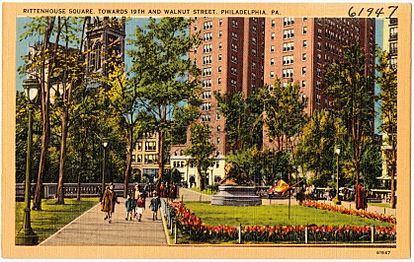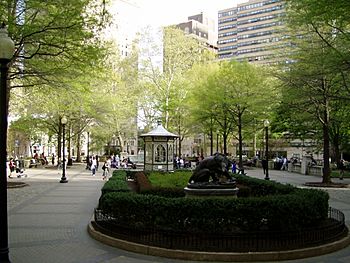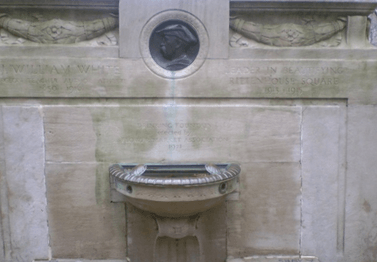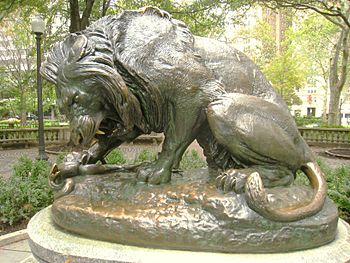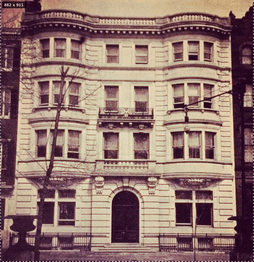Rittenhouse Square facts for kids
Quick facts for kids |
|
|
Rittenhouse Square
|
|
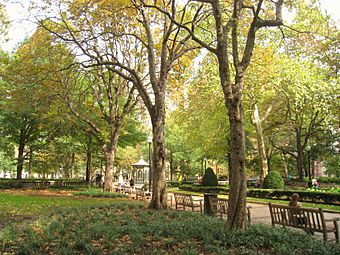
(Autumn, 2010)
|
|
| Location | Philadelphia, Pennsylvania, U.S. |
|---|---|
| Built | 1683 |
| Architect | Thomas Holme; Paul Philippe Cret |
| MPS | Four Public Squares of Philadelphia TR |
| NRHP reference No. | 81000557 |
| Added to NRHP | September 14, 1981 |
Rittenhouse Square is a famous park and neighborhood in Center City, Philadelphia, Pennsylvania, USA. It's one of five original parks planned by William Penn and his surveyor Thomas Holme way back in the late 1600s. The Rittenhouse neighborhood is known for being one of the wealthiest areas in the country.
The park and the nearby Fitler Square make up the Rittenhouse–Fitler Historic District. A non-profit group called The Friends of Rittenhouse Square helps keep the park beautiful. Many people think "the Square" is one of the best public spaces in the United States. The park is about two city blocks long on each side. It is bordered by 18th Street to the east, Walnut Street to the north, and special streets called Rittenhouse Square West and Rittenhouse Square South.
Contents
History of Rittenhouse Square
Originally, this park was called Southwest Square. In 1825, it was renamed after David Rittenhouse. David was a descendant of William Rittenhouse, who was the first paper-maker in Philadelphia. David Rittenhouse was a famous clockmaker and astronomer. He was also a friend of the American Revolution. There's even a crater on the Moon named after him!
Early Buildings and Growth
In the early 1800s, Philadelphia began to grow from the Delaware River towards the Schuylkill River. It became clear that Rittenhouse Square would be a very popular place to live. James Harper, a retired politician and businessman, was the first person to build a home on the square. He bought most of the land on the north side and built a grand house for himself around 1840. This set the tone for the area, making it a fancy residential neighborhood. After Harper passed away, his house became the home of the exclusive Rittenhouse Club.
Changes Over the Years
From 1876 to 1929, many rich families lived around Rittenhouse Square. These included the president of the Philadelphia Railroad, Alexander Cassatt, and department store founder, John Wanamaker. Famous architects like John Notman and Frank Furness designed elegant churches and clubs here.
In 1913, the French architect Paul Philippe Cret redesigned parts of the Square. He wanted it to look like the beautiful gardens in Paris. His designs added classical entrances, stone railings, pools, and fountains. After World War II, many modern apartment buildings and offices were built in the area. This was because of a real estate boom. While some old Victorian mansions were replaced, much of the historic design, like Italianate and Art Deco styles, can still be seen today.
The park has kept its original layout and feel more than the other four original squares in Philadelphia. In the mid-1900s, the park became a safe and welcoming place for different groups of people to gather and connect.
Fun Things to Do and See
Today, Rittenhouse Square is a lively park filled with trees. It's surrounded by tall apartment buildings, fancy hotels, and popular restaurants. You can also find a Barnes & Noble bookstore and a Starbucks nearby. The park's green lawns and many benches are perfect for people to enjoy lunch. The lion and goat statues are popular spots for young children and their parents to meet. Many people also bring their dogs for walks here.
Keeping the Park Beautiful
The park's beauty is largely thanks to the Friends of Rittenhouse Square. This group works with Philadelphia Parks & Recreation. They help with landscaping, lighting, and fixing fountains and fences. They even put out dispensers for doggie bags! In 2013, which was 100 years after Paul Cret redesigned the Square, the Friends group worked hard to raise money for new lighting and to preserve the park. New security cameras have helped reduce vandalism. Park rangers also help keep the park safe and peaceful.
Arts and Culture Around the Square
The Rittenhouse Square neighborhood is home to many cultural places. These include the Curtis Institute of Music, the Philadelphia Youth Orchestra, and the Philadelphia Art Alliance. You can also find the Rosenbach Museum & Library and the Plays & Players theater here. Just two blocks south of the square is Delancey Place. It's a quiet, historic street with old mansions and has even been used as a setting for Hollywood movies.
The square also has many cool sculptures. One is a bust of J. William White by R. Tait McKenzie. Another famous one is Billy, the goat, created by Philadelphian Albert Laessle. He also designed the Penguins statue at the Philadelphia Zoo.
Events at the Square
Rittenhouse Square hosts many events throughout the year.
- The Rittenhouse Square Spring Festival happens in early May. Tens of thousands of people come for food, shopping, and live entertainment.
- In the fall, hundreds of artists from all over the country show their work at the Rittenhouse Square Fine Art Show.
- During the holidays, many people gather for the Rittenhouse Square Christmas Tree Lighting. The tree is lit with over 5,000 bright lights!
- A farmer's market is held every Saturday from 10:00 AM to 2:00 PM. Farmers from the region sell fresh, locally grown food. This event is organized by Farm to City.
Gallery
-
Lion with a Snake by Antoine-Louis Barye (1832)
Education in the Area
Students living in the Rittenhouse Square area attend the Albert M. Greenfield School for grades kindergarten through eight. After that, they go to Benjamin Franklin High School.
Several colleges are also in the Rittenhouse Square neighborhood. These include the Curtis Institute of Music, the University of the Arts, and Peirce College.
The Free Library of Philadelphia has a branch called the Philadelphia City Institute. It's located on Locust Street, inside an apartment building.
Getting Around Rittenhouse Square
Rittenhouse Square is easy to reach using different types of public transportation.
- All SEPTA Regional Rail trains stop at Suburban Station, which is about six blocks northeast of the Square.
- The PATCO Speedline, a train that connects Philadelphia and Southern New Jersey, ends at 16th & Locust Streets. This is two blocks east of the Square.
- Several SEPTA buses run along Walnut Street (9, 12, 21, 42 westbound). The 17 bus runs north on 20th Street and south on 19th Street and Rittenhouse Square West. The 2 bus runs north on 16th Street and south on 17th Street.
- The SEPTA Subway–Surface Trolley Lines have a station at 19th and Market Streets, two blocks north of the Square.
- The Walnut-Locust station on the Broad Street Subway is four blocks east.





